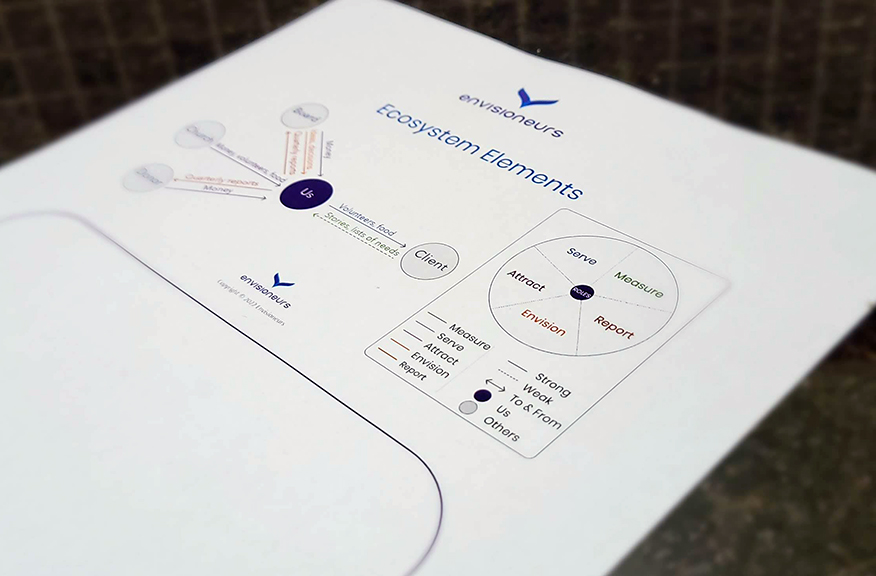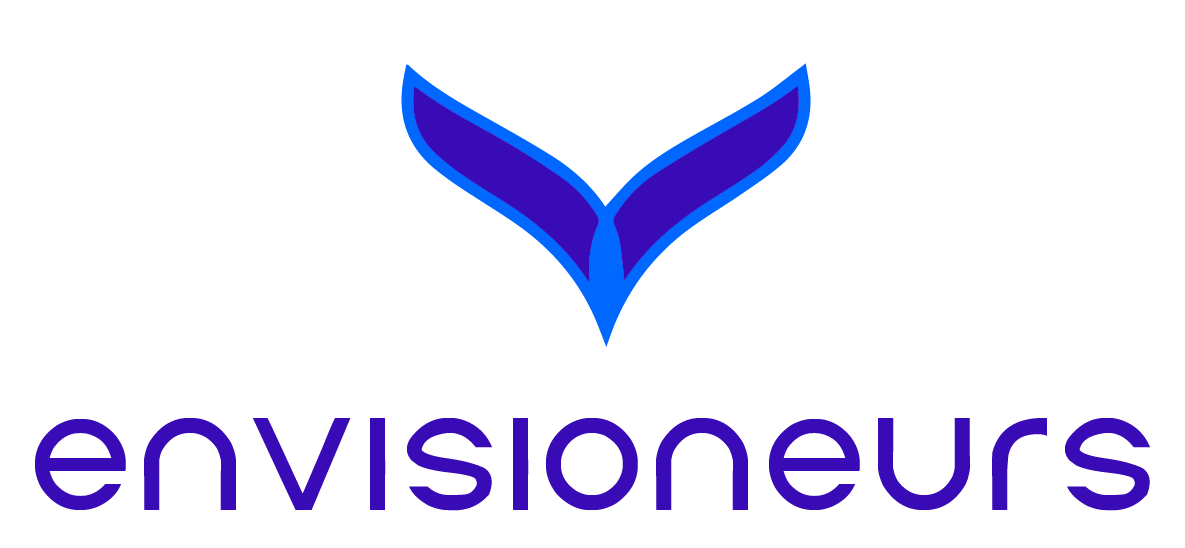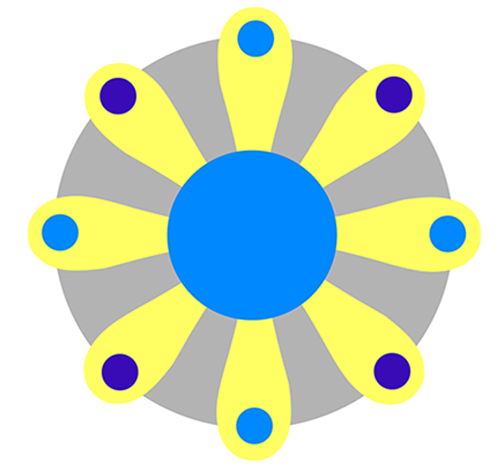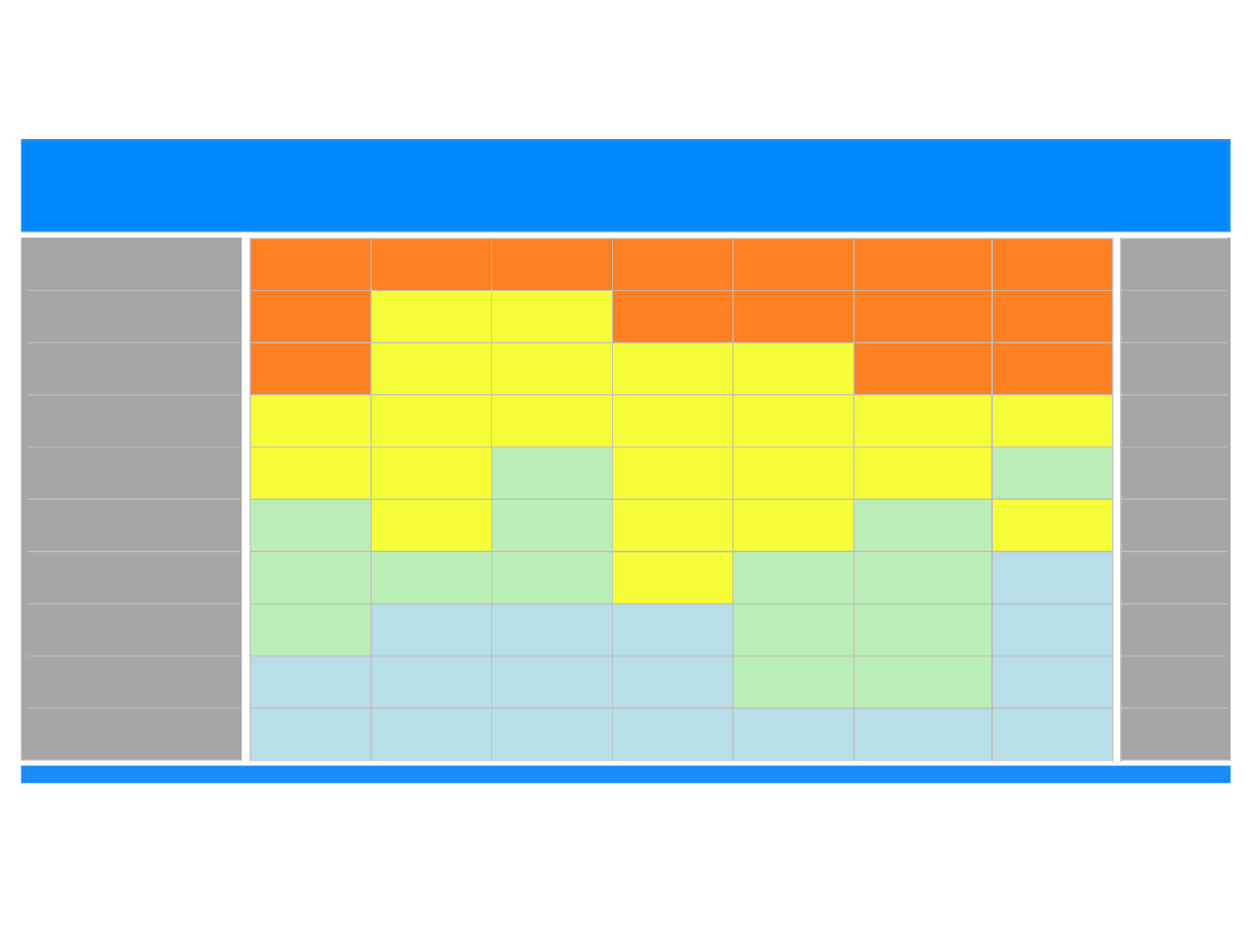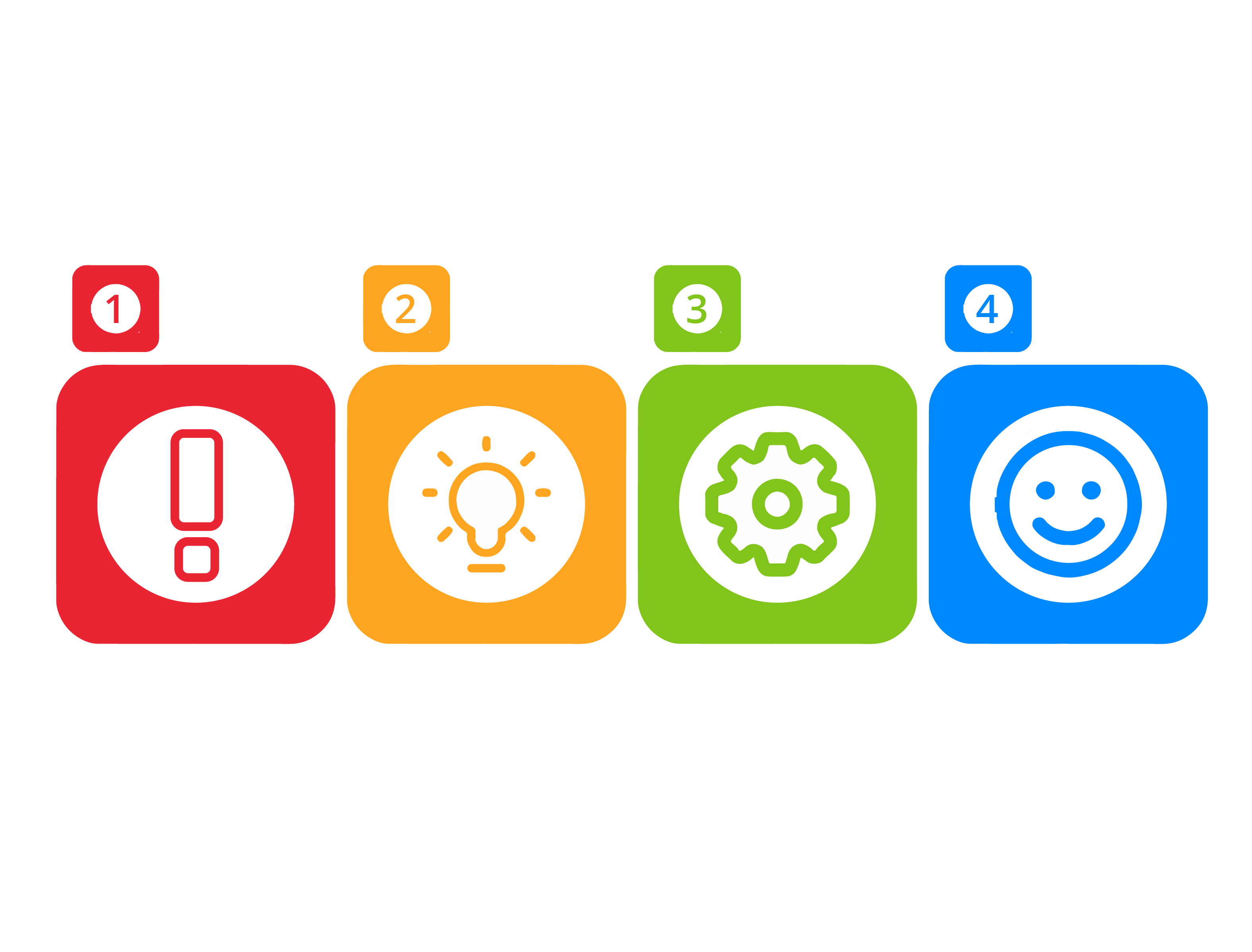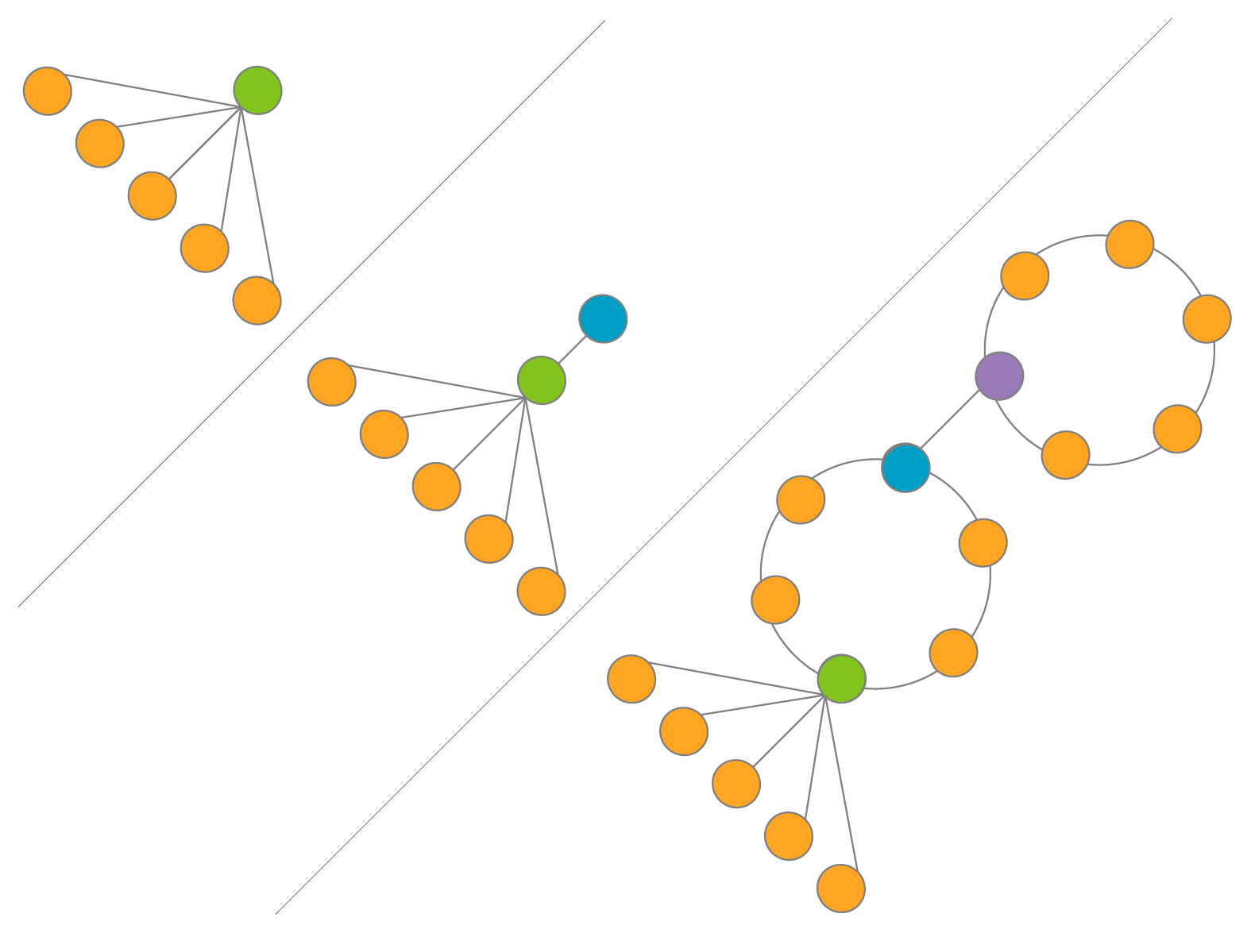Toolkit
This is a sampling of items in our Envisioneurs Toolkit. Our team has created and used the Toolkit for field observations, strategy and ideation sessions, and related innovation work. The tools help teams think strategically, discover underlying assumptions, frame conversations, perceive opportunities, draft scenarios, communicate to stakeholders, and do much more. Click on each icon for a summary of each tool.
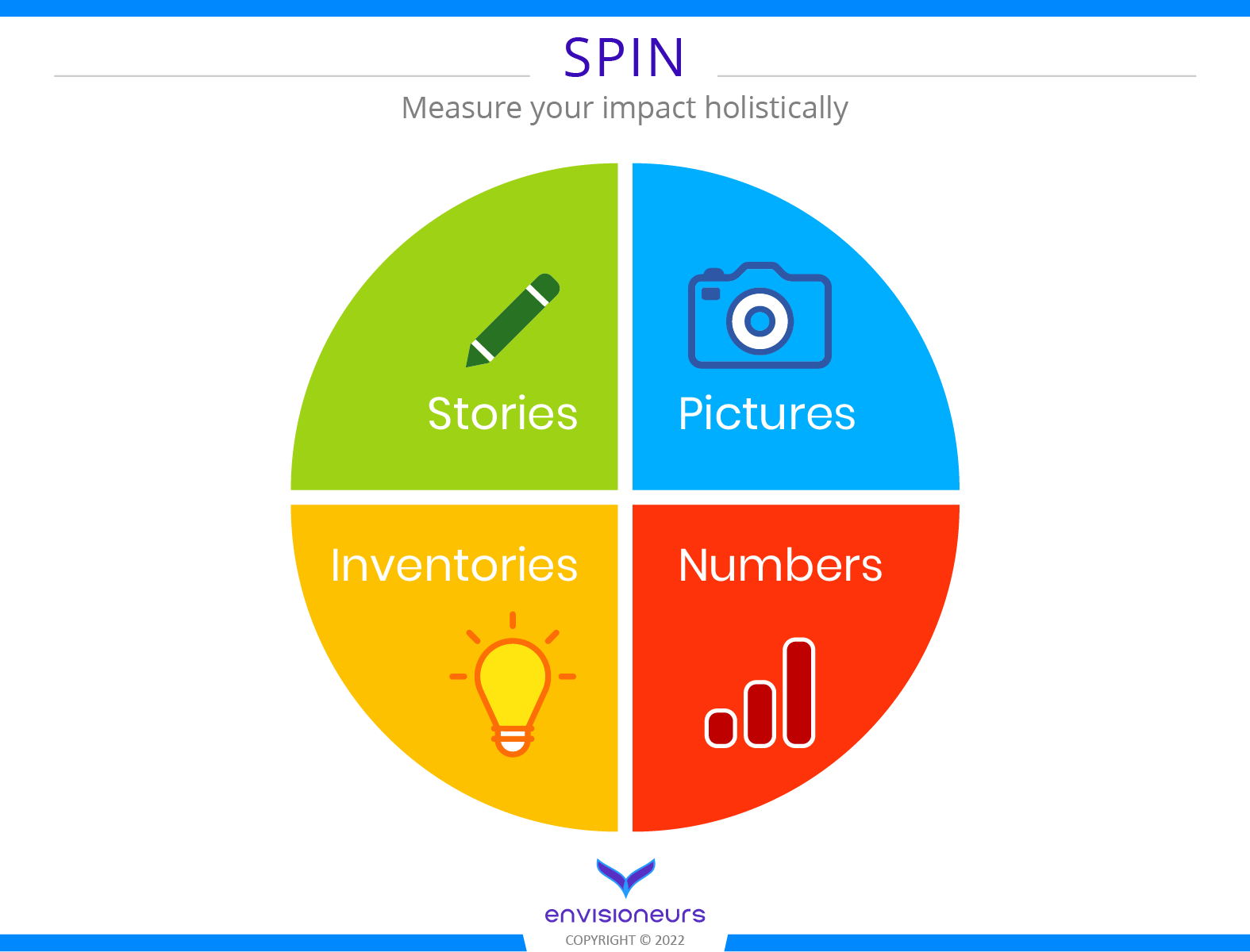
WHEN
The SPIN framework makes evaluation clear and fun. An organization of any scale can use it to gauge mission impact, hone team performance, and report outcomes in a memorable and attractive way. You can focus SPIN on a specific program or service, or to measure your enterprise’s work as a whole. This framework enables you to blend in narratives, photos, diagrams, surveys, skill and knowledge tests, statistics, and other indicators of the impact you are making.
HOW
Gather your team to identify how you will collect these kinds of items about your mission impact:
- Stories to describe how people experience and benefit from a program or initiative.
- Pictures to show what people are doing, where an issue is prominent, or how a natural or built environment is evolving thanks to a program or initiative.
- Inventories to understand the degree to which your audiences learn and apply concepts, or change their mindsets, perspectives, or behaviors.
- Numbers to indicate your level of audience involvement, socioeconomic diversity, financial results, or other impact.
WHAT'S MORE
Train your participants to collect and write meaningful stories, frame and shoot pictures, design and evaluate surveys, and collect and analyze numbers. The better your team members learn these skills, the better they will become as evaluators and communicators, and the more fully you will understand the impact you make in your field.

WHEN
If a major event threatens to alter the course of your enterprise, this is the tool for you. What would you do if you got stuck in the middle of a pandemic? What would you do if your main investor moved abroad and 80% of your funding left with him? What would you do if you just met the perfect strategic partner to elevate your mission to a higher level?
Situations like this often present a complex range of options. You could merge, downsize, expand, etc. Your choices could get messy. Use this tool to dial through your options. Choose the actions that will give your team a clear and sensible path forward.
HOW
Each point on the ring indicates a course of action. For example, if you have stable resources and expect high future demand for your services, you could Reopen a facility you had closed. If you realize one of your client services isn’t as effective as you’d hoped, you could Redesign it. If you just lost funding for a flagship program, you could Reconfigure staff by shifting team members to other programs.
Choose just a few points on the ring so your team will be able to focus on those items. List and forecast your resources, consult with your team to weigh your options, select 1-3 Renewal Ring strategies to pursue, and then apply each of those strategies to a key area of operations. Alongside your Renewal Ring, create a chart to summarize the steps you’ll take and the results you expect to see.
WHAT'S MORE
If you are in a fast-moving situation, return to your Renewal Ring at frequent intervals to reassess your strategies. In addition, note that this is not only a decision-making tool, but also a communication tool. Tell your audiences what you will do and what you won’t. For example: “We are going to Reduce our operating hours and Remove our weekend sports program, but we Reassure you that we will stay in this community and invest the time and personnel to run our core services as well as ever.”
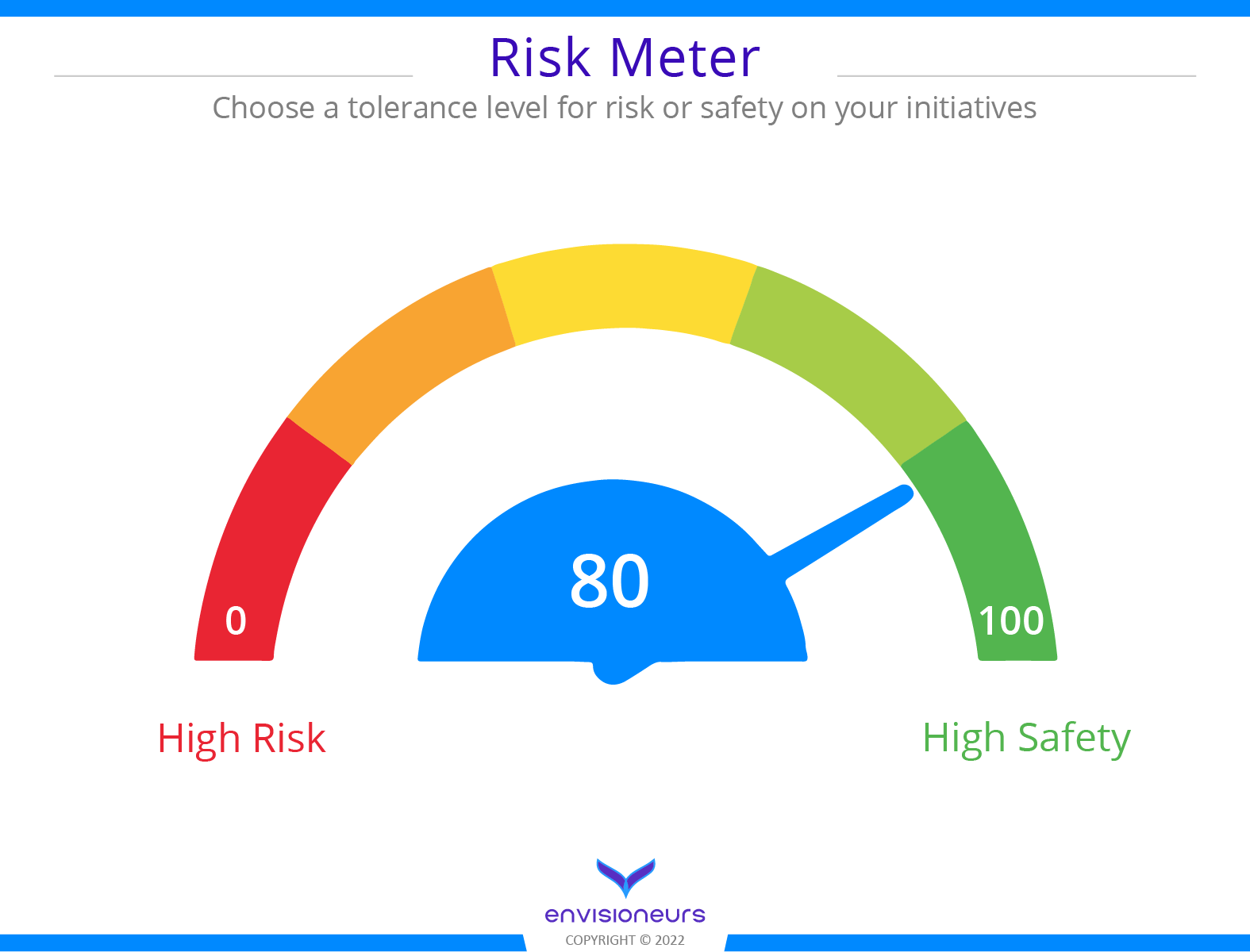
WHEN
Have you ever disagreed with a fellow staff or board member about whether to invest in a program, launch a service, or expand to a new geographic area? Oftentimes tension results from differences in each person’s assumptions about risk. Some people believe risk is a terrible thing that must be avoided. Others embrace it as a path to greater learning and impact. Most people fall somewhere in the middle. Use this tool to learn how much risk each person prefers. Discuss which level seems energizing or tolerable for the kind of future you want to build.
HOW
Conduct a silent activity followed by a conversation. First set parameters for each level on the scale – red means high risk, orange means moderate risk, and so on – and then ask your team members to select their preferred level of risk. Each person should silently circle his or her preferred risk level on the chart. After everyone has selected a preferred risk level, discuss what you’ve learned. Is your team risk-averse or eager for adventure? What are the implications for the decisions you make? How might you respond to participants whose risk tolerance is uncommon for your team? By bringing this topic forward, you can resolve previously unstated sources of conflict and advance towards a shared agreement about how much risk to seek on future projects.
WHAT'S MORE
Return to this tool periodically. As you bring on new board or staff members, you might find that each new recruit has a different view about risk. The sooner you bring these views to light, the easier it will be for you to navigate uncertainty and choose courses of action.
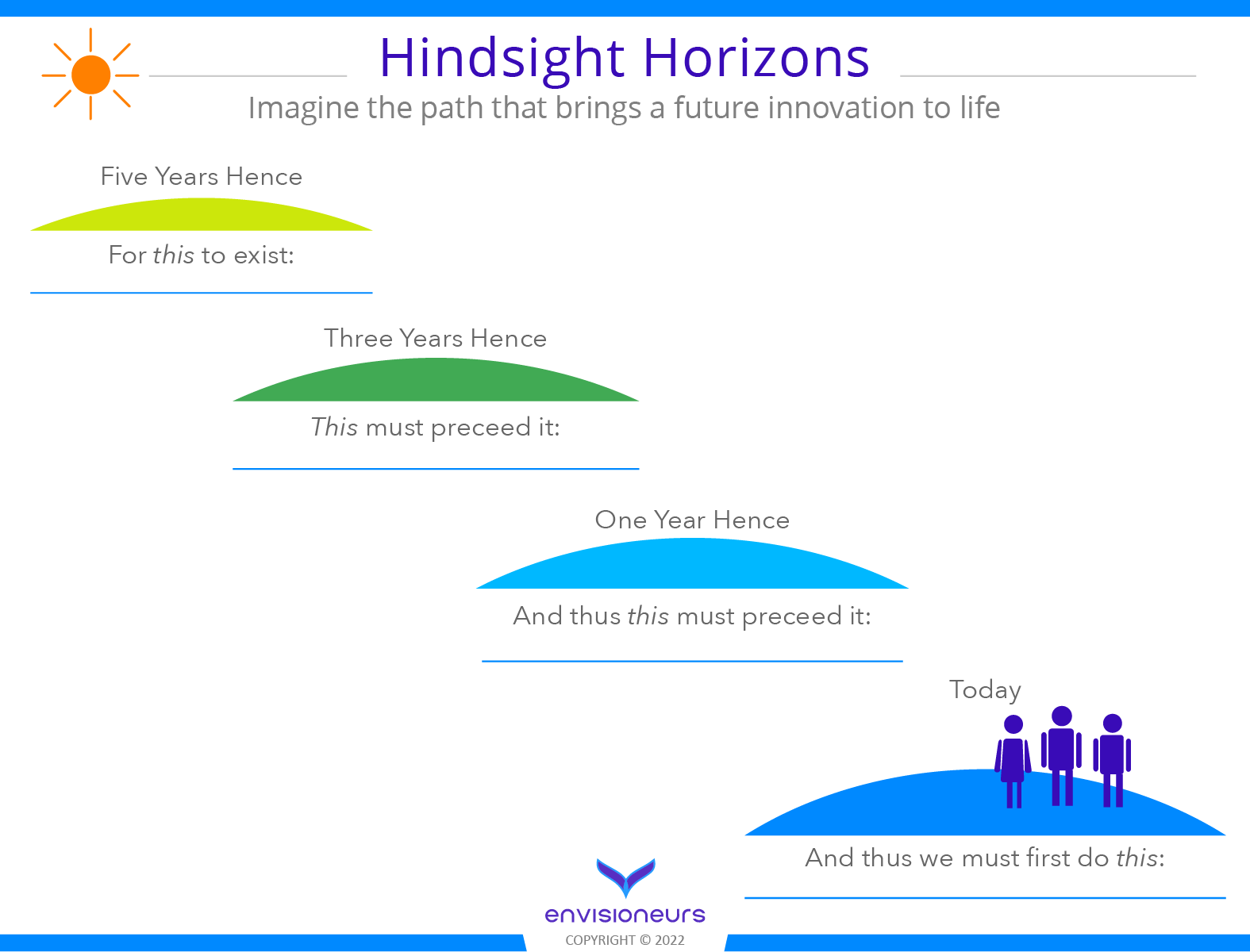
WHEN
When an organization thinks about its future, usually some members of its visioning team flourish. They conjure up vivid ideas about where the enterprise will be in a few years. Usually, too, other team members flounder. They struggle to think about an uncharted future space that seems abstract or unpredictable to them. Hindsight Horizons is a tool we’ve created to help teams think step-by-step about how a future could look. A team starts at Year Five and then moves progressively back towards Today. By taking this stepped approach, the uncharted future becomes more concrete in peoples’ minds and easier for teams to envision.
HOW
Let your most imaginative team members start this exercise. Ask them, “What’d you love to see us doing in five years?” and, conversely, “what would a bleak future look like?” Start filling in each scenario with details. In five years, what problems might your enterprise face? What solutions might you be offering to audiences? What people, facilities, software, money, etc. will you have? And so on. As this vision forms, invite fellow team members to add their thoughts. (Some people are better at imagining something from nothing; others contribute best by responding to a draft.)
After picturing your ideal future five years hence, ask, “What must we be doing by Year Three to advance towards our Year Five vision?” Sketch a Year Three scenario now. Answer questions like those you considered for Year Five. Repeat this process for Year One and then for Today. This stepped approach will help you gauge what to do now en route to your desired future. Repeat this exercise with a “bleak future” mindset to anticipate dangers and develop interventions before it’s too late.
WHAT'S MORE
This tool uses the concept of hindsight since our minds often see causal relationships between items after the fact. Once we see an outcome, we start making logical connections: “What led to that? What else could we have done?” One great thing about becoming an Envisioneur is that you get to exercise both the creative power of envisioning something new and fresh, and the practical, can-do mentality of an entrepreneur to make sure that vision is achievable. You can look towards the horizon and shape the path that will bring you there!
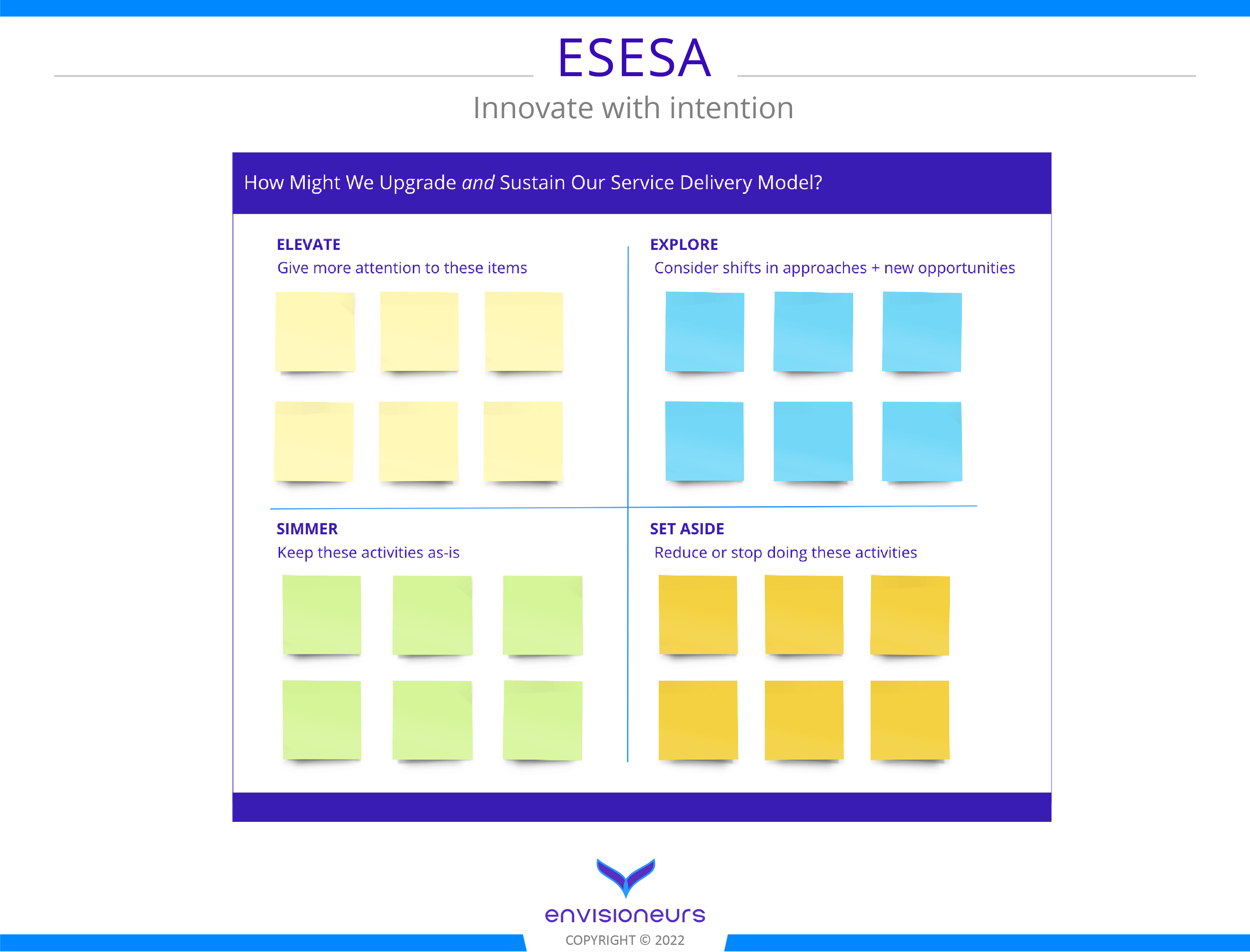
WHEN
If you feel overwhelmed by the many new and continuing things your team could do in the future, how can you get a sense of order and streamline your decisions? The ESESA tool uses a small set of categories to help you sort through your options and then choose a resource mix for each category.
HOW
On a table, write one sticky note to describe each key activity your team does. E.g., each program, service, or form of outreach. Next, identify new things your team could do. E.g., you could launch a novel solution to an issue or expand into new geography. Write each idea on a note, too, and then place each sticky in one of these categories:
- Elevate
Things your team does now, that you want to at a greater scale in the future - Simmer
Things your team does now, that you want to continue to do at roughly the same level in the future - Explore
Exciting ideas that you’ll develop further (you might make prototypes, conduct market tests, or launch these ideas after this exercise) - Set Aside
Things your team does now, or has considered doing in the future, that you will pause or cease to do (these items might not be priorities for the near future due to staff, budget, or other constraints)
Use discussions and research to score and sort your choices further.
WHAT'S MORE
You can run multiple sessions, in each case talking to your clients, staff, board, or partners. If these audiences categorize your options similarly on the ESESA grid, you may feel reassured about your team’s direction and priorities. If these groups differ, though, you may need to re-think your market positioning. You may also need to decide which audiences’ goals matter most to you.
Display your completed ESESA diagram in a prominent place to remind your team about where to invest its efforts in the future.

WHEN
Heat Maps can help you make sense of complex social issues and decide which issues to tackle. For example, a community foundation could address Impact Areas such as educational attainment, health and nutrition, senior care, transportation infrastructure, or other topics, but it may decide that it should channel its efforts toward only the “hottest” areas. These areas could be where community need and market demand are greatest, and where your board and staff have the best capabilities, resources, and desire to make an impact. The Heat Map lets you color-code each Impact Area so that you can compare a wide range of issues in a single page.
HOW
Identify potential Impact Areas (leftmost column of the Heat Map). Score each in terms of stakeholder input, research studies, statistics, or other top factors (in the “Engagement or Validation Score” columns). Each score should be based on criteria and thresholds that you define. E.g., if stakeholder input is important to you, define hot, warm, neutral, or cold threshold points to characterize responses to a stakeholder survey. Impact Areas that generate high scores qualify as hot. Those that yield lower scores are warm, neutral, or cold. Some scores may be based on numbers such as demographic statistics. Others may require judgment calls based on comments, observations, or other verbal and written input, as with interviews.
By plotting and coloring all Impact Areas on one page, it becomes easier to study your options than if your team were to spend a meeting flipping through dozens of documents. Color-coding also helps you decide based on research about what is actually happening, instead of relying on assumptions or anecdotes.
Once you’ve color-coded your Heat Map and chosen promising Impact Areas, decide what role to play (rightmost column). E.g., you could become a leader, funder, or advocate. For low-scoring Impact Areas, you may stay on the sidelines while other groups tackle those issues.
WHAT'S MORE
If your team struggles to agree on the choice of Impact Areas, keep in mind that your Heat Map is designed for a moment in time. You could revisit it periodically, update it with new insights, and then reassess whether your nonprofit has chosen the right Impact Areas or should switch to others.

WHEN
A fun way to think about your work is to analogize it to sports, where a team plays “home games” in its stadium and “road games” elsewhere in its league. For you, home games could the activities you perform at your headquarters, while road games could be activities that you perform at satellite locations. This distinction can help you generate ideas about how to design and deliver services. For example, what uniforms, equipment, advertising, etc., would be best to weave into your home operations, and what kinds would be best to extend your work out in the community?
HOW
Turn this into an imagination exercise. Think about how to make your team stronger so that it can win more road games – perhaps by investing in grassroots outreach or learning about the resources and traditions in distant communities that you want to serve better. Imagine how you might win more home games, too. Perhaps you can create warm and welcoming touchpoints with the clients you serve in your home office. Many sports teams perform well at home but struggle on the road. Champions tend to excel in both environments. Use this analogy to inspire your enterprise to perform well at home and on the road.
WHAT'S MORE
The construct of “home” and “road” may energize conversations about who your audience is, too. Maybe your team would benefit from a new definition of what and where its home is. Maybe you will find that you are serving certain road locations well but neglecting others. If you think about your organization and your community in these terms, you can emerge with a more meaningful understanding of where your team plays today…and where it should play in the days to come.
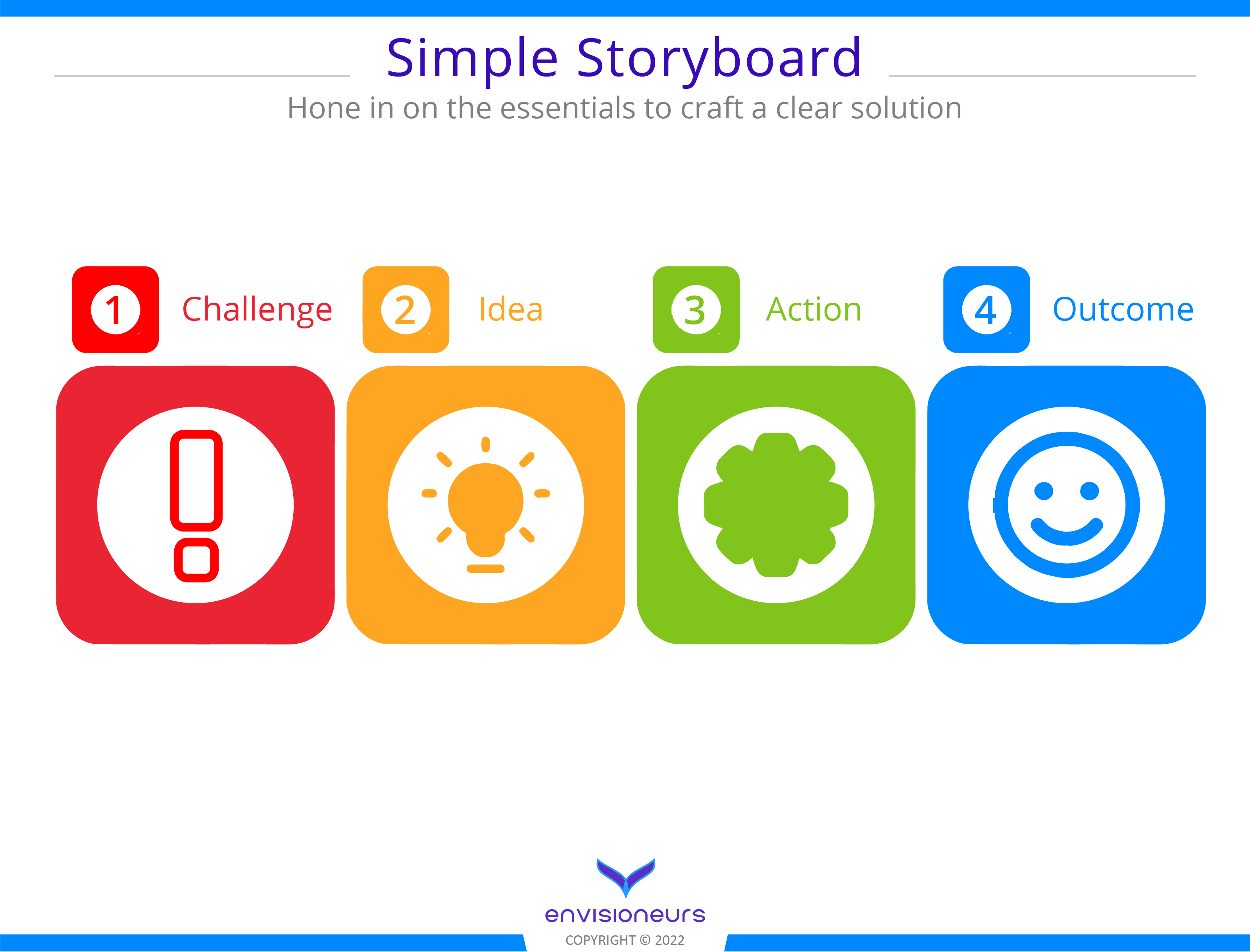
WHEN
When you read a book or an article, what draws you into the story? There may be a compelling character who encounters a challenge. How will an athlete overcome an injury to shine in a tournament? How will a mother find her child who accidentally boarded a train to New York instead of Newark? The conflict may lead to actions that ultimately result in success. The athlete heals in time and wins an Olympic medal, while the mother catches a faster train and arrives in time to reunite with her wayward child in Manhattan.
In a similar manner, you can use narratives to envision new products and services. Conceive of your audiences as characters and ponder the challenges they face. Imagine the actions you could take to address those challenges. Emerge with great outcomes from the actions you bring into the narrative.
HOW
This tool can spark great ideas if you focus on one character at a time, as follows:
- Character and Challenge
Identify a single client as your central character. What challenge does this person face? Think about why the challenge exists and what its implications are. Perhaps a certain cause is the root of a problem. Maybe a chain of events heightens the challenge. Describe these things like an author writing a novel. - Idea
Come up with a fresh idea about how to help this character. Maybe you could connect this person to a wise elder on your team or offer an easily accessible new service. - Action
Describe how the action would work in practice. What would each person in the story need? Where would the action happen? As you write, you might discover that your idea would be best for a certain time or place. You’ll sense how to make your idea as full and as practical as possible. - Outcome
Now, think about likely outcomes, both good and bad. Will your idea really lead to a better result for your character? Might it actually make this person worse off? Imagine possibilities and then decide whether to adjust your idea to boost the odds of success.
Write narratives for other perspectives, too. How would the story unfold for various clients, members of your staff, or new people you’d like to reach? Your stories can lead to great solutions!
WHAT'S MORE
You might wonder whether your team has the skill to write great stories. Maybe your imaginative colleagues would flourish with this exercise, but you just don’t know it yet. A narrative exercise can unearth hidden talents on your team – or within yourself – that are waiting to be activated. Don’t limit the story-making role to certain positions on your team. Instead, invite everyone to participate.
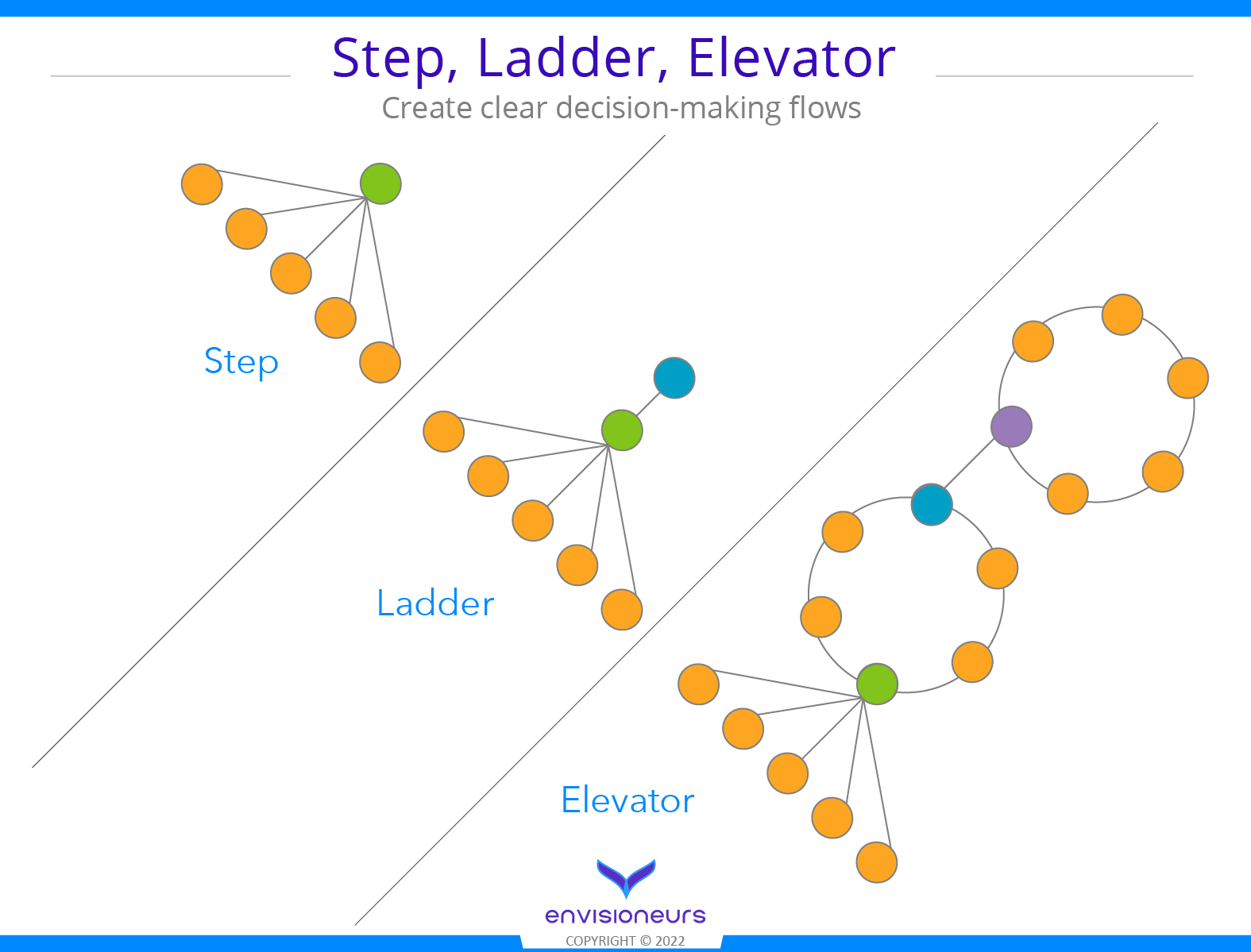
WHEN
Organizational structures are designed to guide communications and decisions, but few address all situations. Sometimes disagreements arise about who is supposed to approve a concept, who should give input, or who needs to stay informed. A visual aid can help teams cycle through cases where the decision-making process isn’t yet clear, and gradually emerge with a systematic – or flexible – approach. The Step Latter Elevator tool illustrates how you can make decisions in a hierarchical setting. You can adjust it to match the culture and structure of your team.
HOW
In these diagrams, four dots represent people in an enterprise:
- Orange dot: a member of a staff, executive, or board team
- Green dot: a decision-maker at the front-line or managerial level
- Blue dot: an Executive Director
- Purple dot: a Board Chair
If uncertainty or tension affects some decisions, designate someone to keep records of such cases. Gather 4-6 members from across your team to review these cases periodically so you can learn what perceptions, assumptions, frustrations, and wishes exist in terms of how decisions get made. Address questions such as, “When we faced this case, why was it so hard for us to take action? What slowed us? What confused us? Who had the best insights and knowledge to make the decision? Whose support was invaluable in getting this decision adopted across our team?” And so on.
Use the Step Ladder Elevator diagram to discuss whether a topic merits a quick decision (Step-level), approval from an executive (Ladder-level), or even a review and an approval from the board (Elevator-level). Gradually, you will arrive at clearer criteria or policies for decisions. Present your decision-making framework to your board for approval, and then share it across your enterprise.
WHAT'S MORE
Some decisions may require specialized input, such as when they require approval a government regulator, so adjust the model to match your situation.
As you use this model, you may find yourself thinking more and more about relationships between members of your team, knowledge and expertise that are crucial to a decision, and ways that fellow team members may need to stay engaged. You may also realize that lots of decisions don’t require executive-level attention. Furthermore, this diagram may encourage everyone to be more adept at sharing insights up, down, and across your enterprise.
WHEN
Organizational structures are designed to guide communications and decisions, but few address all situations. Sometimes disagreements arise about who is supposed to approve a concept, who should give input, or who needs to stay informed. A visual aid can help teams cycle through cases where the decision-making process isn’t yet clear, and gradually emerge with a systematic – or flexible – approach. The Step Latter Elevator tool illustrates how you can make decisions in a hierarchical setting. You can adjust it to match the culture and structure of your team.
HOW
In these diagrams, four dots represent people in an enterprise:
- Orange dot: Member of a staff, executive, or board team
- Green dot: Decision-maker at the front-line or managerial level
- Blue dot: Executive Director
- Purple dot: Board Chair
If uncertainty or tension affects some decisions, designate someone to keep records of such cases. Gather 4-6 members from across your team to review these cases periodically so you can learn what perceptions, assumptions, frustrations, and wishes affect decisions. Address questions such as, “When we faced this case, why was it so hard to take action? What slowed us? What confused us? Who had the best insights and knowledge to make the decision? Whose support was crucial in getting the decision adopted across our team?” And so on.
Use the Step Ladder Elevator diagram to discuss whether a topic merits a quick decision (Step-level), approval from an executive (Ladder), or even a review and an approval from the board (Elevator). Gradually, you’ll arrive at clearer criteria or policies for decisions. Present your decision-making framework to your board for approval, and then share it across your enterprise.
WHAT'S MORE
Some decisions may require specialized input, such as when they require approval a government regulator, so adjust the model to match your situation.
As you use this model, you may find yourself thinking more and more about relationships between members of your team, knowledge and expertise that are crucial to a decision, and ways that fellow team members may need to stay engaged. You may also realize that lots of decisions don’t require executive-level attention. Furthermore, this diagram may encourage everyone to be more adept at sharing insights up, down, and across your enterprise.
Who Should Use These Tools?
These tools are designed for Initiative Design and Thought Partnership activities. Most are great for small groups of staff and community members. Some tools, such as the Renewal Ring or Step Ladder Elevator, are helpful for boards, too.
